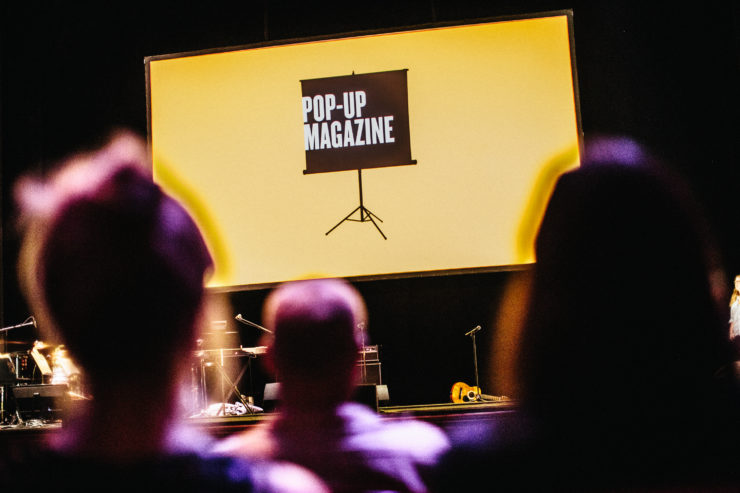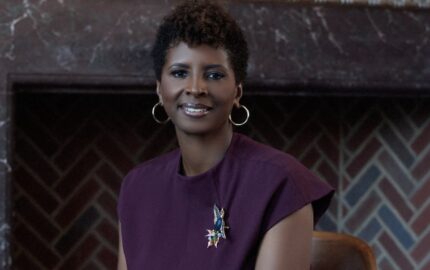In today’s age of distraction, reading an entire longform story in one sitting — never mind an entire magazine —seems like a lost art. Emails, text messages, Facebook notifications and all those open browser tabs beckon, bringing our attention elsewhere every few paragraphs.
Pop-Up Magazine offers people the chance to consume a publication from start to finish, distraction free, in a couple of hours. There’s a catch, though. Pop-Up is a “live magazine,” with reported stories performed in front of audiences. It’s not filmed, recorded or captured in any way, so there’s no way to access it later. It’s an in-the-moment, blink-and-you-miss-it experience.
“It’s a live show that takes its inspiration from the classic ideal of a general interest magazine,” says co-founder and editor in chief Doug McGray.
Reporters, photographers, filmmakers, musicians, artists and other performers (Beck, John C. Reilly, and Lindy West are just a few examples) take the stage to share stories that are often complemented by multimedia components and a live score from Magik*Magik Orchestra.
The show, McGray says, mirrors your typical magazine: “The pieces tend to start off faster, more fun, drawing inspiration from the classic front-of-the-book idea, and then moving into something a little bit more like a feature level.”
"I think it's an eclectic, pretty young, very curious crowd. We try and make a show that satisfies that curiosity.”
Founded in San Francisco in 2009, Pop-Up started as an event held at a small Mission District theater. Now it sells out 3,000-seat venues across the country in minutes.
Pop-Up made its way to Boston for the first time this month, bringing 10 pieces to life in front of a packed audience at The Wilbur Theatre. The topics and narrators was wide-ranging; emojis, voicemails left for alcohol companies’ customers service departments and the similarities between Curtis Mayfield and Chance the Rapper were among the subjects explored. The performers included “This American Life” producer Stephanie Foo, author and music critic Jessica Hopper, and Ben and Rhonda Partain, a blind couple who told the story of their first date three-plus decades ago.
The Partains were a crowd favorite, as was the closing act, in which documentary filmmaker Tim Hussin shared the story of former opera singer Tim Blevins, who now struggles with addiction, health problems and homelessness. The performance seemed to be ending on a sad note; after Hussin presented clips from his documentary on Blevins for the San Francisco Chronicle, he said he had lost touch with the singer. But then Blevins came onstage and, showing off his booming baritone voice, brought the audience to its feet.
So who is Pop-Up for? “We think of our audience as very curious people,” says McGray, who is also the editor in chief of California Sunday Magazine, a monthly print magazine launched by Pop-Up in 2014. “I think they are people who read a lot of smart stuff and who watch interesting things on TV, on their phone, or in theaters, who listen to great radio, great podcasts. I think it's an eclectic, pretty young, very curious crowd. We try and make a show that satisfies that curiosity.”
I talked to McGray about Pop-Up Magazine and live storytelling. Here are the edited and condensed excerpts of our conversation:
Now is a great time for the art of live storytelling, whether it’s first-person personal storytelling events like The Moth, variety shows like those put on by “This American Life” or even TED talks. Why do you think we’re seeing more and more of these types of events—from different outlets, across various platforms—in recent years? What accounts for the increasing popularity of live storytelling?
All of those examples are a little bit different. TED is doing a different thing than The Moth is. They're drawing different communities. They're working in different genres.
One thing we have found is we all live very full online lives. We get to connect with people all over the place. We have social media friends. We have real people who we've had correspondence with for years who we've never met, and that's great. It gives us access to this whole eclectic world of ideas and people.
A really nice complement to that is to go out, turn off the phone for a couple of hours, be somewhere with people, see something live, talk about it afterwards and meet up for drinks. I don't think that's a new need. People have been gathering together forever, but I think right now it's especially nice. It's not in any way a rejection of or a reaction to our online lives. It's a very nice complement.
What specifically sets Pop-Up Magazine apart from other live storytelling events?
I think there are a couple of things that are especially distinctive about it. One is how deeply multimedia it is. For most of the stories there is narration. There is also something happening on the screen. We'll shoot things the way a magazine will.
We'll commission photography. We'll commission animation. We commission live music so that there's a soundtrack underneath the story. Mixing together visual storytelling, narration and a live soundtrack is interesting and pretty distinctive.
Also, it's primarily not a night of personal storytelling. If we have 10, 11 or 12 stories in a show, we'll always have a couple of classic memoir pieces in the same way that a magazine might. It's also made up of profiles, dispatches and even things like lists and essays. Obviously everything has a live spin on it, but we try and have the variety of formats that you see in a magazine and a lot of reporting.
What about participating in Pop-Up is attractive for journalists, especially those coming from print or digital mediums that don’t involve interacting directly with audiences? What can participants take away from the experience and perhaps even apply to their day jobs?
It's an interesting assignment because you start to think about what kind of story would I report and tell for a live audience? If I have three, four, five, six or eight minutes and a screen and the potential for music underneath me, a band playing next to me. A live audience that will actually laugh at the jokes and I can hear them -- in some cases a really large audience. It's not something that you do all the time.
"That’s one of the pleasures of going to it, which is you can see that the people onstage are all incredibly talented. They’re doing something that is different for them. It’s not their everyday thing. The audience, they have to participate in that. It’s part of what makes it feel intimate, that we’re all in this together."
I think people who participate in the show really enjoy it. On the one hand, they get to do what they're good at. They're onstage because they're great at finding and telling stories, but then they're also getting to play around with this new format. We work closely with people, help them think it through, and help make sure it's a great experience.
Sometimes it gives people a chance to do something completely unlike anything they would otherwise do, [and] because there's no real template, it gives people a chance to think about stories in a really open‑ended way
I have a good example. About a year ago we introduced Jenna Wortham, who is this great writer for The New York Times who proposed a story.
When we were thinking about our direction for it, we introduced her to Manual Cinema, this really innovative shadow theater company based in Chicago. She wrote this beautiful reported story about memory and our relationships with technology. That's a very short pathway of describing it, but it is such a really riveting human story that has a lot to do with memory.
Manual Cinema illustrated it live with shadows on stage, shadows that looked almost like animation. If you're a journalist, it's not that often that you're going to have your work illustrated live with shadows and have a band singing with you. That's not what we do every day. That's part of the fun.
What is the biggest challenge of putting a Pop-Up Magazine show together?
The biggest challenge is also one of my favorite things about it, which is we're making it up as we go. I saw Dave Chappelle once and he was talking about standup and how standup required an audience, how you develop your thing. You develop your material in front of an audience. You work it out in public.
This idea of live, multimedia journalism as a way to bring people together is this great experiment that we get to do in public. Every time we do a show, somebody will talk to us afterward about an idea they have, and it's something we haven't thought of before. That's great. It also means that, in the best way, in the most fun way, we're constantly problem-solving. That's really the pleasure. That's one of the pleasures of going to it, which is you can see that the people onstage are all incredibly talented. They're doing something that is different for them. It's not their everyday thing. The audience, they have to participate in that. It's part of what makes it feel intimate, that we're all in this together.
One unique element of Pop-Up Magazine events is that you invite the audience to go get drinks with the Pop-Up team and the performers following the show. Have you been doing that since the beginning? What’s the motivation behind doing so?
Since the very beginning. The very first show, it was two kegs in the trunk of my car. Whenever the theater has a bar, whenever it has a big enough space we could go together, we always stick around after [or] find some reasonably big bar, very close by and announce on the stage that that's where we're going after.
A lot of times you'll see [similar events] have a Q&A. You can stand up in the back of the room, you can take the mic, and you can ask a question across the vast room to somebody onstage. We had always hoped for a bit more intimacy with the whole show. We want the people to actually meet each other.
One of the things I love is, if you're in the audience and someone performs this really amazing story onstage and you want to know more about it -- it's some topic you've never thought about before, or you just think they're fascinating and you want to meet them -- you walk up to them. Everybody is incredibly friendly.
You can meet performers, you can ask questions. You can also meet other people in the audience. One of the things I love about the show is they draw an incredibly interesting crowd. I've met so many interesting people, people as interesting as the people onstage, in the audience at these shows. It's amazing filmmakers, it's amazing writers, it's amazing creative people, designers, architects. People in different sorts of creative fields. It's people who work in tech and startup companies. It's lots of really interesting people. That's the pleasure, too. I think it's really easy to come to a show and go home having talked to and met a bunch of interesting people.



